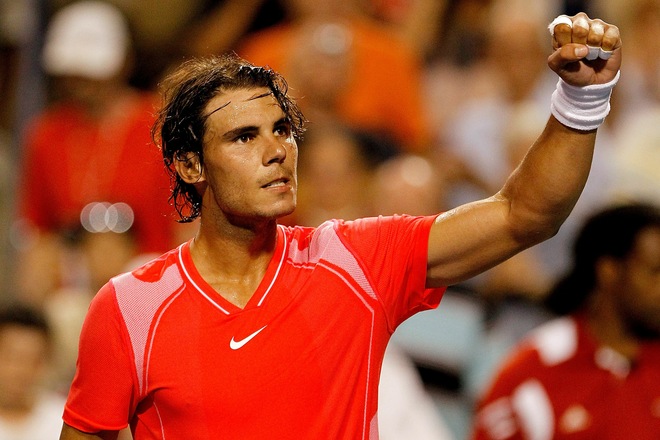By Charles Bricker
This wasn’t even close to a World War II battleship coming out of mothballs. Still, there was no mistaking the rust dripping off Rafa Nadal’s game in his first match in 37 days.

He had, for him, an astounding 27 unforced errors in a 92-minute opening set against his other Swiss foil, Stan Wawrinka, including two blown overheads. He also had to deprive Wawrinka of five set points and work harder than usual to rein in a succession of wild forehands on the way to a 7-6 (12), 6-3 victory on an oppressively humid night in Toronto.
Coupled with a first-round bye, Nadal, the richly deserving No. 1 player in the world, is now into the third round at this crucial ATP 1000 event and will next play the tall, slender, ace-serving South African Kevin Anderson.
As difficult as the first set of this match was for Nadal, it was, in a greater sense, a blessing. Having not played since winning Wimbledon on July 4, he needs time on court, and he got all he wanted in the sometimes brilliant, sometimes disturbingly bad opening set.
Torpid he wasn’t. The movement is there. God, can he run and play defense. But that delicate timing that exists among feet, stroke and ball contact was understandably lacking after more than a month away from the tour.
There were timing problems as well for No. 3 Roger Federer in his opening win over Juan Ignacio Chela. But, like Federer, by the second set Nadal was much closer to form. He’ll tell you he has a few more matches to go before he’ll declare himself back in top gear. But does anyone doubt he’ll get there sooner than later.
After 27 unforced errors in the opening set, 16 off the forehand side, Rafa had just nine misfires in the second. But he was very close to having to take this one three sets to win.
He blew two points in the tiebreak to go down 3-5 — first with a backhand volley over his head that he failed to angle off, leaving Wawrinka one more shot, which he hit for a winner. Then, on an overhead that Nadal probably could hit from a lounge chair, he smacked the ball about 20 feet beyond the baseline.
But he never relented on his aggressiveness, working on the assumption that all these points, won or lost, would ultimately help him find his rhythm.
Poor Wawrinka, the No. 2 Swiss behind Federer. He’s now 0-6 vs. Nadal and 0-13 in sets. Nadal vs. both Swiss players: 20-7. Nadal since losing to Andy Roddick in the semis at Key Biscayne in April: 32-1.
Watching first Federer on Tuesday and then Nadal on Wednesday produced some interesting tactical changes. Federer was working for the first time with former Pete Sampras coach Paul Annacone and Federer looked more aggressive than he has in previous matches this year. He’s attacking service returns more, no longer blocking balls back.
As for Nadal, who used to hit about 99 percent of his serves into the ad court with a 99 mph slice to the corner. Yet he scarcely went that route with Wawrinka, preferring instead to work on his up-the-line serves, and he was effective. In the deuce court, Nadal took away Wawrinka’s big cuts by serving a lot of body shots. He is, at age 24, a fully matured player — not only physically but mentally. He is so good at mid-match tactics.
The second set didn’t resemble the first in any way. Nadal broke to 3-1 by stepping in on a couple of Wawrinka serves to the ad court and pasting back forehand winners up the line. After facing three break points in the opening set, he was never threatened on serve in the second.
As tight as this match was in the opening stages, it was good for Nadal. He’ll be a lot smoother in the third round because of the tension of the tiebreak and the number of points they played.
Charles Bricker can be reached at nflwriterr@aol.com. He is an alumni of the University of California at Berkeley and has had 41 distinguished years in the news business, covering 25 NFL seasons and Super Bowls and for the last 16 years, he has covered men’s and women’s professional tennis. Listen to Charlie every Monday at 7 pm – and on podcast – on World Tennis talk at http://primesportsnetwork.com/tennis.html
